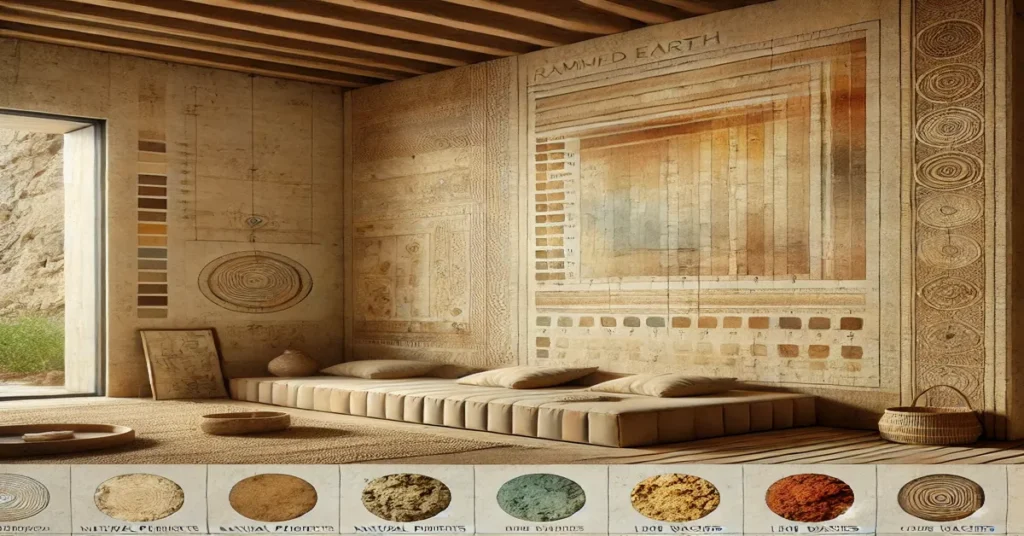Rammed earth painting construction is an ancient building technique that has seen a resurgence in modern architecture due to its sustainability, durability, and natural beauty. Structures made from rammed earth are created by compacting a mixture of earth, clay, and water into a mold to form solid walls. The result is a structure that is not only environmentally friendly but also visually stunning, with rich, earthy textures and tones.
While rammed earth structures are often left unfinished to highlight the natural beauty of the material, many architects, designers, and artists have explored the practice of “rammed earth painting.” This unique approach involves adding color, textures, and sometimes designs to the surface of rammed earth walls to enhance their aesthetic appeal while preserving their natural integrity. Rammed earth painting combines art and architecture, creating a harmonious balance between structure and decoration.
This article will explore the concept of rammed earth painting in-depth, covering its techniques, materials, applications, and benefits. We’ll examine how rammed earth painting can enhance both interior and exterior spaces, and why this form of decoration has gained popularity in sustainable design and construction.
What is Rammed Earth Painting?
Rammed earth painting refers to the application of color, patterns, and textures onto rammed earth surfaces, which can include walls, floors, and even exterior facades. The primary aim is to enhance the aesthetic appeal of the structure without undermining the natural, rustic quality that rammed earth provides.
Unlike traditional painting on surfaces like drywall or concrete, rammed earth painting requires special considerations due to the porous, uneven surface of the material. The earth’s natural textures and colors vary, and so do the techniques used to paint it. Artists and designers may use natural pigments, washes, or special paints that adhere well to the textured, earthen surface.
Rammed earth painting can serve various purposes:
- Decorative Enhancement: To add visual interest through patterns, colors, or artistic designs.
- Protective Coating: Some paint applications can help protect the surface from weathering, moisture, and other environmental factors.
- Symbolic or Cultural Expression: Many ancient cultures used pigments and paintings on earth-based structures to convey stories, symbols, or cultural heritage.
Techniques for Rammed Earth Painting
Painting on rammed earth is not the same as painting on conventional materials like wood or concrete. The natural texture and absorbency of the rammed earth surface require unique techniques and materials that will adhere effectively. Here are some commonly used techniques:
1. Natural Pigment Washes
A popular method of adding color to rammed earth surfaces is through the use of natural pigment washes. These washes are typically made from earth pigments, clay, or other mineral-based substances, mixed with water to create a translucent layer of color that preserves the natural texture of the surface. Natural pigment washes can bring out the tonal variations in the earth, creating a warm, blended effect that enhances the organic look of the wall.
Steps to Apply Pigment Washes:
- Mix the pigment with water to achieve a wash-like consistency.
- Use a brush or sponge to apply the wash in even strokes.
- Allow the pigment to soak into the wall for a subtle, lasting color.
Natural pigments also offer a wide variety of earthy hues, including ochres, siennas, and umbers, which complement the natural aesthetic of rammed earth.
2. Lime Washes
Lime wash is a traditional technique that has been used on earthen surfaces for centuries. Lime-based paints are breathable, eco-friendly, and naturally antimicrobial. They also add a layer of protection to the surface, as limewash has a high pH level that deters mold growth.
Application of Lime Washes:
- Mix lime powder with water and apply with a brush.
- Apply multiple coats, allowing each layer to dry before adding the next.
- Lime washes develop a chalky texture that enhances the surface’s natural look.
Lime washes are an excellent choice for rammed earth painting because they are compatible with the material’s natural properties. They allow the surface to “breathe,” which helps manage moisture levels and prevents cracking.
3. Acrylic Paints and Mineral Paints
For those seeking more vibrant colors or detailed designs, acrylic and mineral paints can be used. Mineral paints are highly durable, water-resistant, and bind well to mineral-based surfaces like rammed earth. Acrylic paints can also be used but may require a primer or bonding agent to adhere well.
Application Techniques for Detailed Paintings:
- Apply a bonding primer to ensure the paint sticks.
- Use brushes or stencils to create detailed designs or patterns.
- Seal with a protective coating if needed, particularly for outdoor applications.
Using acrylics or mineral paints allows artists to experiment with designs, from geometric patterns to mural-style art, offering a contemporary twist on traditional earthen surfaces.
4. Stenciling and Patterning
Stenciling is a popular technique to add patterns or motifs to rammed earth walls. Stencils can be custom-made or purchased and allow for precise, repeatable designs. This technique is especially useful for creating decorative borders, tribal patterns, or symmetrical designs.
How to Stencil on Rammed Earth:
- Place the stencil on the wall and secure it in place.
- Use a natural pigment or paint and gently apply over the stencil with a sponge or brush.
- Remove the stencil carefully and allow the paint to dry.
Stenciling is ideal for adding cultural or symbolic designs, as well as intricate, decorative borders.
5. Wax or Oil Finishes
Wax and oil finishes are commonly used to enhance the texture and color of rammed earth surfaces. While not technically “paint,” these finishes can bring out the richness of the earth’s colors and add a subtle sheen.
Application of Wax/Oil Finishes:
- Apply a natural wax or oil (like beeswax or linseed oil) to the surface.
- Rub the finish into the wall with a cloth to create a smooth, polished look.
- Buff for a soft, satin sheen.
These finishes are particularly useful for interior walls, adding a luxurious touch while preserving the natural beauty of the material.
Materials Used in Rammed Earth Painting
When painting on rammed earth, the choice of materials is crucial. Here’s a look at some of the commonly used materials:
- Natural Pigments: Derived from minerals and plants, natural pigments offer earthy, subtle colors that blend seamlessly with rammed earth.
- Lime: Lime is breathable and mold-resistant, making it a popular choice for lime washes on rammed earth walls.
- Acrylic and Mineral Paints: For more vibrant colors or intricate designs, acrylic and mineral-based paints can provide the necessary adhesion and durability.
- Linseed Oil and Beeswax: These natural oils and waxes enhance the wall’s color and protect the surface, giving a polished appearance.
Advantages of Rammed Earth Painting
Rammed earth painting offers several benefits, both functional and aesthetic, that make it an appealing choice for those interested in sustainable design:
- Environmental Sustainability: Using natural pigments and lime-based paints aligns with eco-friendly practices, reducing the use of synthetic chemicals and promoting a green aesthetic.
- Enhanced Aesthetics: Rammed earth painting allows for creativity and customization, turning plain walls into works of art that blend with the surrounding environment.
- Improved Durability: Certain finishes, such as lime wash or oil-based coatings, add durability and protect the wall from moisture and weathering.
- Cultural and Artistic Expression: Rammed earth painting allows for the incorporation of cultural symbols, motifs, and colors, creating a connection to local heritage and traditions.
- Natural Breathability: Earth-based materials like lime allow the walls to breathe, which can be beneficial for maintaining air quality and managing indoor humidity levels.
Applications of Rammed Earth Painting
Rammed earth painting is versatile and can be used in various settings:
1. Residential Interiors
In homes, rammed earth painting can create a warm, inviting atmosphere. Subtle pigment washes or decorative stenciling on interior walls can add a unique touch to living spaces, bedrooms, or hallways. Lime wash or natural pigment washes are especially popular for interior applications, as they create an earthy, calming effect.
2. Public and Commercial Spaces
Rammed earth painting is becoming more common in eco-conscious hotels, restaurants, and public buildings. These spaces benefit from the aesthetic appeal and sustainable message conveyed by rammed earth. Decorative stenciling, bold color applications, and cultural motifs can be used to enhance the ambiance of commercial spaces while emphasizing their environmental values.
3. Exterior Facades
When applied to exterior walls, rammed earth painting can enhance the visual appeal of a building while protecting it from weathering. Durable finishes like lime wash are commonly used for exteriors, as they help maintain the structural integrity and color of the earth. Using natural or earth-tone colors allows the structure to blend with its surroundings.
Challenges and Considerations in Rammed Earth Painting
While rammed earth painting offers many benefits, there are some challenges to consider:
- Surface Porosity: Rammed earth is a porous material, which means it absorbs paint differently than other surfaces. This can make it difficult to achieve an even finish.
- Durability in Harsh Conditions: Exterior rammed earth walls painted with natural pigments or lime wash can be susceptible to wear and fading over time, especially in harsh climates. Additional protective finishes may be necessary.
- Application Techniques: Working with natural pigments and lime-based materials requires skill and knowledge. Proper preparation and application are essential to achieve a lasting and aesthetically pleasing finish.
Conclusion
Rammed earth painting’s is a fascinating blend of art and sustainable architecture. By adding color, texture, and design to rammed earth walls, this practice allows for the creative expression of both artists and designers while respecting the natural beauty of the material. Rammed earth painting’s not only enhances the aesthetic appeal of a structure but also aligns with eco-friendly building practices, making it an excellent choice for those looking to incorporate art into sustainable design.
From natural pigment washes to intricate stenciling, the techniques and materials used in rammed earth painting’s provide endless possibilities for customization and artistic expression. As eco-conscious construction gains popularity, rammed earth painting offers a unique way to blend sustainability with style, creating spaces that are both functional and beautiful.
FAQs
- What is rammed earth painting?
- Rammed earth painting involves applying color, patterns, and finishes to rammed earth walls to enhance their visual appeal.
- What materials are used in rammed earth painting?
- Common materials include natural pigments, lime wash, mineral paints, and protective finishes like linseed oil or beeswax.
- Can rammed earth walls be painted with regular acrylic paint?
- While possible, acrylic paint may require a primer or bonding agent. Mineral-based paints and natural washes are generally better suited.
- Is rammed earth painting environmentally friendly?
- Yes, especially when using natural pigments and lime wash, which align with eco-friendly and sustainable building practices.
- How durable is rammed earth painting?
- Durability depends on the materials and finishes used. Lime washes and mineral paints provide better protection than standard paints.
- What are the challenges of painting rammed earth?
- Challenges include surface porosity, achieving even color, and potential weathering for exterior applications, especially in harsh climates.







